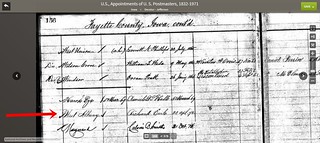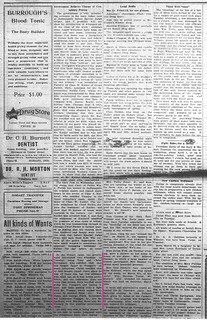Here are a couple of pages from the
1835 Liverpool ledger where I encountered a new (to me) name: Richard Earle.
 (Click on images to enlarge)
(Click on images to enlarge)
This image and the one below courtesy of the Hobart Historical Society.

I thought that his presence in this brand-new town with George Earle meant that there must be some family relation, so I started poking around, and fell down a rabbit hole.
The Hobart Historical Society has a genealogical file on the Earle family, and also sells a 1972 booklet by Dorothy Dunning Ballantyne:
George Earle and Family of Hobart, Indiana. Both sources state that George Earle had a brother named Richard. Anonymous typewritten genealogies in the file give Richard's birth year as either 1811 or 1814. (In either case he would have been old enough to be doing business in Liverpool in 1836.) One genealogy in the file, entitled "Kinship of John Earle," further states that Richard had at least two children, Joseph (b. 1839) and Edwin (birth year unknown).
Then we look in Hobart's census records. The only place we find a Richard Earle is in the
1860 Census. He is in the household of John and Miriam Earle (George's son and first daughter-in-law). Richard, who is relatively prosperous, is described as a builder, born in England, 40 years old — not quite right, but close (as you might expect if you're getting your information from a nephew).
 (Click on image to enlarge)
(Click on image to enlarge)
Here's where things get confusing. A couple of Ancestry.com users have compiled family trees that include Richard Earle. These users think Richard was living in Iowa in 1860, and they have evidence to back that up: the census of Westfield Township, Fayette County, Iowa records a Richard Earle, 45 years old, born in England, a "laborer" but
slightly more prosperous than the Hobart Richard Earle.
 (Click on image to enlarge)
(Click on image to enlarge)
And among his children are sons named Joseph and Eddy — which could be Edwin, thus making this information agree with the genealogy at the Hobart Historical Society.
It's possible that Richard was counted twice, if he split his time between Iowa and Indiana.
In a statewide business directory published in 1862
[1] we find evidence that Richard Earle was still doing business in Hobart at that time:
 (Click on image to enlarge)
(Click on image to enlarge)
It's interesting that he is listed as a cabinet-maker, because one of the Iowa family trees on Ancestry.com includes this image of a "guide" for cabinet-makers and upholsterers, on which one Richard Earle of Falmouth [England], where George Earle was born, proudly wrote his name in 1835:
 (Click on image to enlarge)
(Click on image to enlarge)
The records compiled by the Iowa contingent show that soon after making his appearance in our ledger in 1836, Richard left Indiana. In 1838, in Stephenson County, Illinois, he married a Catherine Brown.
[2] The
1850 Census finds the couple and their young children still in Stephenson County, in the town of Freeport; Richard describes himself as a carpenter. The next census, as we've seen, records Richard and his family in Iowa (and Richard alone in Hobart). In the
1870 Census of Westfield Township, Fayette County, Iowa, Richard gives his occupation as miller.
This 1878
History of Fayette County, Iowa, records that Richard Earle got into the mill business in a town called Albany:
Albany has been wiped off the map even more thoroughly than Ainsworth. I found a
website devoted to its history; towards the bottom of the site are some excerpts from "Chats with Old Timers" (a series that ran in a local paper in the 1930s-40s, I gather) that include someone's misremembering the mill owner as George, not Richard, Earle.
Richard was appointed postmaster of "West Albany" (which may have been something like "East Ainsworth") in 1872
[3], thus finally matching George on that score, too.

Richard died in 1879 and is buried in
Fayette County, Iowa.
♦ ♦ ♦
I wish I knew what the point of all this is, because I just spent about two solid days gathering this information and writing it up.
In conclusion, I will just say: I think you should name towns after
all your living brothers, or
none of them. Playing favorites is not nice.
_____________________
[1] Ancestry.com. U.S. City Directories, 1822-1995 [database on-line]. Provo, UT, USA: Ancestry.com Operations, Inc., 2011: Third Edition of Geo W Hawes and Co's Indiana State Gazetteer and Business Directory, 1862-63.
[2] Ancestry.com. Illinois, Compiled Marriages, 1791-1850 [database on-line]. Provo, UT, USA: Ancestry.com Operations Inc, 1997. Original data: Dodd, Jordan, Comp.. Electronic transcription of marriage records held by the individual counties in Illinois.
[3] Ancestry.com. U.S., Appointments of U. S. Postmasters, 1832-1971 [database on-line]. Provo, UT, USA: Ancestry.com Operations, Inc., 2010. Original data: Record of Appointment of Postmasters, 1832-1971. NARA Microfilm Publication, M841, 145 rolls. Records of the Post Office Department, Record Group Number 28. Washington, D.C.: National Archives.



















